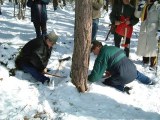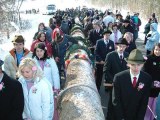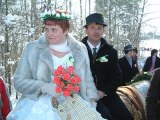Tree
Trunk Pulling
Until the middle of the 20th century
the Slovenes in
If no villagers get married between Christmas
and Ash Wednesday, the marriageable youths of the village are being
“punished”: They have to organise the so-called “Tree Trunk
Pulling” on Carnival Sunday. Pulling a fir tree trunk, which has been cut
in a forest, symbolises a joke marriage. The participants of the event pull the
tree trunk through the village impishly, masqueraded as bride’s male
attendant, wedding guests and flower children. A young woman dressed up as a
bride and a young boy dressed up as a groom sit on this very tree trunk. After
the “marriage” has ended, the tree trunk is auctioned. The auction
proceeds are used for events of amusement (proms) and for covering expenses.
The tree trunk mainly is a fertility symbol. This custom was adopted by both
the Slovenes and the Hungarians of Vas County from German-speaking Austrians.
The tradition of tree trunk pulling dates back to the year 1904. At that time,
Slovenes from Andovci / Orfalu followed this custom for the first time. And so
did Slovenska Ves / Rábatótfalu in 1909.



Photos: weekly journal „Porabje“
This
custom is either called “the fir tree marriage” (baurovo,
gostüvanje) or “tree trunk pulling” (plojek vlejčti, baur
vlejčti, baur vlečenje, plojek vlečenje)
This joke
marriage used to be organised mostly on Carnival Tuesday or sometimes even
already on the Monday before. However, since 1968 this custom is followed
always on Carnival Sunday. The whole village participates in this marriage
parody. Even the descendants of the villagers, relatives from the cities and
latterly also Slovenes from the Raba Region living abroad travel to their
homeland in order to attend this event.
The
masked figures, which appear in this custom, can be divided into two main
groups: The first group plays the crucial role in the event (the
“bride” and the “groom” as well as the “best
man”, the “devil”, etc.). In the second group one can find
the supporting characters, which accompany the procession with colour (the “barber”,
the “wedding guests”, the “gipsy”, etc.)
The
script of the tree trunk pulling that took place in Števanovci and Andovci
in the year 1999 read as follows:
1) The meeting
2) Breaking-up
in order to look for the groom, asking for her parents’ approval and
saying
goodbye to the family of the bride
3) The wedding
guests leave for the forest
4) The
ceremonial cutting of the tree
5) The return of
the wedding guests pulling the “tree trunk of dishonour” (on the
way
much jugglery and fun)
6) The first
announcement (the text shall be shouted out loud)
7) The devil
climbs the chimney, which has to be cleaned by the sweep
8) The second
announcement (the text shall be shouted out loud)
9) The devil
captures the bride (the groom has to look for her and find her)
10) The third
announcement on the place of espousal
11) The espousal
ceremony
12) Auctioning
the tree trunk
13) The wedding
feast
14) The wedding
celebration
15) The
bride’s dance
16) Dancing
until the break of dawn
*
Director: Károly Krajczár
In the
Slovene

Photos: weekly journal „Porabje“
Thanks to
the historic political changes in 1990 (border zone lifting, the opening of new
border crossings) this festive can appear in a new light today. Since also
border crossings, which are otherwise closed are opened on this very day
temporarily (for example in Andovci / Orfalu). As a consequence, also numerous
guests from the neighbouring villages in the Mura Region in
Translated from German into English: Joël Gerber
The German text is based on: Mukics Mária, „A Magyarországi
Szlovének“; Press Publica, (2003)